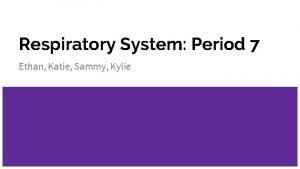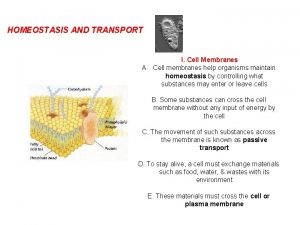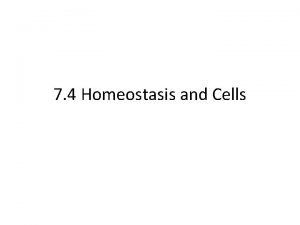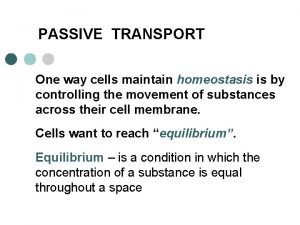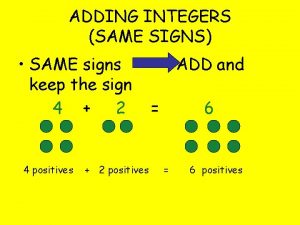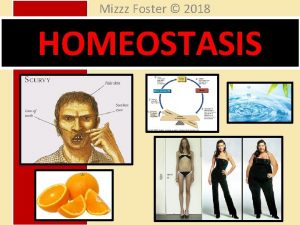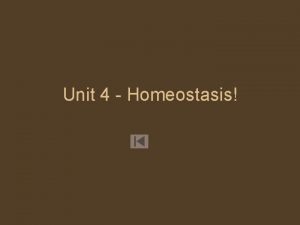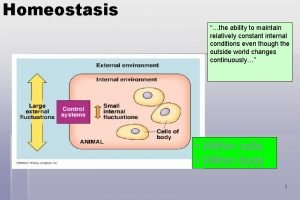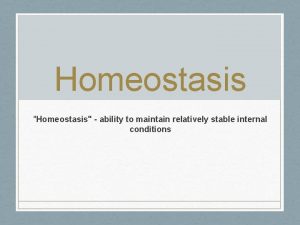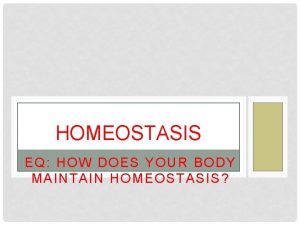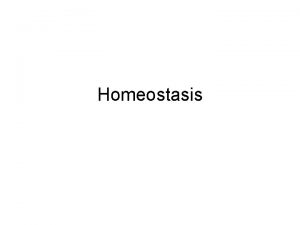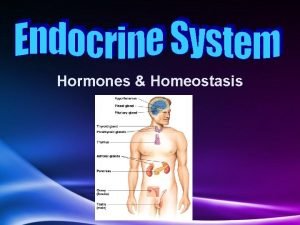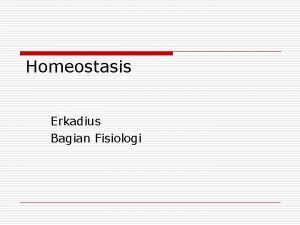Homeostasis Glossary Maintain keep up Constant the same



























- Slides: 27

Homeostasis

Glossary • Maintain – keep up. • Constant – the same. • Internal – inside the body. • Environment – surroundings of the body.

What is Homeostasis? • Homeostasis - the ability of the body of an organism or cell to maintain stable internal conditions even when the outside environment changes continuously.

Homeostatic control involves 3 components • Receptor – sensor, responds to changes and sends information to • Control center – determines the set point, the point at which the variable is to be maintained. • Effector – output, sends the response to the stimulus.


For example

Video Time • http: //www. mhhe. com/biosci/bio_animations/ MH 11%20 Homeostasis_Web/index. html

Video: Eye Pupil Reflex • https: //www. youtube. com/watch? v=Yj 5 -c. Jg. VX 3 c


Homeostasis is maintained through 2 mechanisms: 1) Negative Feedback - (most common) 2) Positive Feedback


Homework • Answer all 10 problems • State whether positive or negative and why

What is the difference between positive feedback and negative feedback mechanisms?


i Insulin Binds to glucose And transports it Into the cells

What is Diabetes? Why does a high concentration of glucose in the bloodstream cause excessive urination and thirst?



What is a system? • System – a group of bodily organs that function together to maintain homeostasis and thus, the survival of the organism.

Biological Levels of Organization

Organelles • Small cellular structures that perform metabolic functions for the cell.

Cell • Most basic unit of all living things

Tissue • A group of similar cells that performs a specific function.

Organ • Formed of two or more tissues and carries out a specific function.

Organ Systems • A group of organs that work together to perform a vital body function • E. g. , the nervous system.

Systems Can’t Work Alone

Video • https: //www. youtube. com/watch? v=ZRFykdf 4 k. Dc
 Section 5-2 active transport
Section 5-2 active transport Respiratory system maintain homeostasis
Respiratory system maintain homeostasis How do cells maintain homeostasis
How do cells maintain homeostasis What do unicellular organisms do to maintain homeostasis
What do unicellular organisms do to maintain homeostasis How does diffusion help maintain homeostasis?
How does diffusion help maintain homeostasis? One way cells maintain homeostasis is by controlling
One way cells maintain homeostasis is by controlling Bioflix activity homeostasis hormones and homeostasis
Bioflix activity homeostasis hormones and homeostasis Bioflix activity homeostasis hormones and homeostasis
Bioflix activity homeostasis hormones and homeostasis Keep satisfied manage closely monitor keep informed
Keep satisfied manage closely monitor keep informed Keep satisfied manage closely monitor keep informed
Keep satisfied manage closely monitor keep informed Keep it secret keep it safe
Keep it secret keep it safe Same signs add
Same signs add Line regulation
Line regulation Glossary of usage
Glossary of usage Ap spanish lit reading list
Ap spanish lit reading list Aklat pamagat
Aklat pamagat Glossary icon
Glossary icon Managed futures glossary
Managed futures glossary Chaucer glossary
Chaucer glossary Use case glossary
Use case glossary Expertir
Expertir Osha glossary of terms
Osha glossary of terms Private equity vs venture capital
Private equity vs venture capital A thousand splendid suns the kite runner
A thousand splendid suns the kite runner Who health promotion glossary
Who health promotion glossary Map with boltss
Map with boltss Cscmp supply chain management definitions and glossary
Cscmp supply chain management definitions and glossary International glossary of hydrology
International glossary of hydrology

